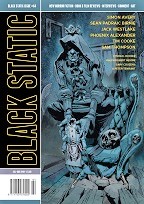 Black Static #64, July/August 2018
Black Static #64, July/August 2018
“Something to Burn” by Phoenix Alexander
Reviewed by Jason McGregor
If you’re not picky about genre, this issue of Black Static is a good one. A third of it is non-fantastic horror dealing with insanity. Oddly, the fantastic stories, while generally very readable, aren’t as good except for the last (fourth overall), which is superb and the best of the issue.
“Something to Burn” by Phoenix Alexander
“You” are about to commit suicide when, “I,” the pillow-man, arrive, in this bizarre variant of It’s a Wonderful Life (with an element from The Wizard of Oz). I do various things to keep you from killing yourself, including transporting you to a happy time in your past while narrating the story of my own strange creation and existence which becomes increasingly disturbing. I end up dragging you to my own past, revealing my own suicidal nature before things take a fictionally problematic turn.
Despite using one of my least favorite narrative devices, this was both delightful and disturbing in a good way, at first, but the two tones led me to expect a stronger ending than the partly clever but essentially weak one it has.
“Out of the Blue” by Sean Padraic Birnie
Though this is a novelette, all that happens is that the narrator’s father shows up on his doorstep a few months after the father’s death. He has no sign of life aside from being able to move on command and is not decayed or decaying. So the narrator invites him in and adapts.
This mixes good observations of what seeing a body at a funeral is like and things of that sort with odd lapses like a discussion of a rabbit leading to the unintentionally ridiculous image of a woman in a rabbit pen. It’s not bad but lacks drama and I’m not sure what, if any, symbolism I’m supposed to draw out of it.
“Asylum” by Tim Cooke
As “Out of the Blue” has the protagonist dealing with a father’s (strange sort of) death, so this shortest tale in the issue seems to be about a protagonist dealing with a grandfather’s senility at an asylum and his eventual death fairly long ago. Even the asylum is now decayed as the protagonist wanders through the lavishly described woods around it and through his mind and time (including a reference to The Blair Witch Project) but, beyond that, I couldn’t make much sense of it.
“The Monstrosity in Love” by Sam Thompson
Nicholas narrates, with economical precision and utmost confidence, the tale of his relationship with Amy Semper, whom he met when she was 22, and how their lives went through times of growing closer and further apart over the next 46 years.
As the story elegantly unfolds, readers will come to recognize it as an example of a generally overdone subgenre but this one had fresh elements and uses the traditional ones well. The narrative voice, particularly through the imminent or actually violent moments, was superb and it effectively uses its genre elements to take a usefully skewed look at life, love, time, and mortality.
“The Blockage” by Jack Westlake
A woman is trying to clean her clogged outdoor drain at her new place when the shadow of a smiling and helpful neighbor falls on her. Over the next few days, as the woman continues to work on the drain, looks for her missing cat, and gets to know the neighbor and learns about his wife (who wanders around at night crying), things get very bad in a simple and powerful way.
This is a horror story without a speculative element and is extremely disgusting but that is by design. Other than some logistical confusion during a physical confrontation, there’s really nothing wrong with this superbly creepy story which is effectively conceived, efficiently executed, and memorable.
“Why We Don’t Go Back” by Simon Avery
The narrator is a middle-aged man at loose ends when he finds himself involved with Eleanor and her daughter, Lily. Eleanor’s abusive ex, Adam, won’t go away and, after he sends both Eleanor and the narrator to the hospital, Eleanor decides to emphatically abandon her job at a jewelry store by becoming a diamond thief. The narrator becomes the “getaway” driver and they go to stay with Eleanor’s half-brother, a priest whom she’s never met. Unfortunately, the priest is not the good kind and, at the village of the corn, with its The Shining-like maze, in this case, of maize, things turn to horror.
This novelette has many minor problems and one large one but is still above-average. The minor problems include a repetition of a line about “a priest, of all things” on pages 55 and 59, the fact that a getaway driver is not shown to be necessary, that Eleanor doesn’t throw away her phone and nothing bad comes of that, the villain is awfully talkative, the corn is unrealistically dense, an unhelpful villager becomes conveniently helpful at one point, etc. The larger problem is that this seems set up to be a clash between good people doing bad things and others doing good things which have bad consequences or to at least carrying on in the realistic vein of the earlier portion of the story which is so extraordinarily effective. Instead, while this is a second story without a speculative element, its conventional over-the-top horror ending clashes with the beginning. Still, the characterization, the complex realism of the unromanticized diamond heist, and the sheer drama of the end compensate for the problems.
More of Jason McGregor’s reviews can be found at Featured Futures.